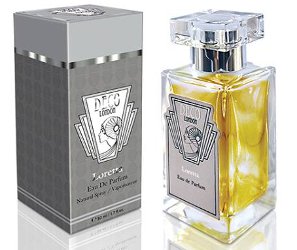
Despite the fact that so many people seem to be doing it these days, it can’t be easy to launch a perfume house. Apart from having — or hiring — the actual perfume know-how, you have to think of a concept. If you don’t have a celebrity or fashion house to hang your branding on, what will set your fragrances apart?
Sophia Fannon-Howell, founder and creative director of Deco London, settled on history. London’s 1920s, to be exact. Working with Robertet, she created a collection of six fragrances — three feminines and three masculines — that she says “blends classic fragrance accords with modern wearability and fashionable design, adds a pinch of British humour and a dose of 1920s glamour and serves up an elegant cocktail of fragrances for the ‘Bright Young Things’ of today.”
Who doesn’t want to smell like an elegant cocktail? I sampled the Deco London feminines: Constance, Loretta, and Millicent.
Loretta
Loretta’s notes include orange blossom, osmanthus, rose, jasmine, patchouli, moss, amber, musk, vanilla and vetiver. Once its initial burst of honeysuckle-like flowers and citrus subsides, Loretta is a gentle, vaporous, mossy osmanthus-infused chypre that reminds me in character of Ann Gérard Perle de Mousse with a sliver of shaved orange blossom soap on top. It’s blessedly dry and nicely blended, youthful but ladylike and subtle.
In my mind, Loretta is perfect for someone with good taste who doesn’t want to make a statement. No one else knows that her jacket is lined in pale green silk constructed as artfully as its wool exterior, and she doesn’t care. She wears her perfume for herself.
Millicent
Millicent’s notes include bergamot, mandarin, honeysuckle, orange blossom, jasmine, lily, ylang ylang, patchouli, cashmere woods and musk. Every perfume collection seems to need to have a big white floral, and Millicent is Deco London’s entry. Except that Millicent isn’t particularly big. It’s a mature woman’s fruity gardenia-tuberose blend without the green underpinnings (Frédéric Malle Carnal Flower) or gaseous drama (Piguet Fracas) that give this sort of fragrance the character I think it demands. Millicent also carries a dose of orange blossom, which you’d think would make it smell more youthful, but makes the fragrance curiously stodgy.
Millicent does keep a shimmer going as it wears — imagine a pearlescent topaz, if such a thing existed — which, for me, is what keeps it from getting too cloying. Almost. It’s also relatively quiet for a gardenia-tuberose style of perfume. Still, if you aren’t a fan of white florals, approach with caution.
Constance
Constance’s notes include bergamot, mandarin blossom, mimosa, raspberry, rose, pink pepper, jasmine, patchouli, sandalwood, labdanum, vanilla, beeswax and musk. Constance is the spicy oriental of the bunch, and like its sisters Loretta and Millicent, it’s blended to a silky pudding and is softer and less assertive than most fragrances of its type.
Constance’s spice — a touch of cardamom, maybe? — is subtle. The warm, ambery cushion that makes up an oriental is restrained and threaded with rose petals. Up top, a piquant wisp of orange blossom (Deco London seems to love its orange blossom) balances the smooth, warm base and easygoing heart notes. Constance doesn’t have a hugely distinctive signature, but it’s easy to enjoy, like a warm fire or a shortbread cookie. I can imagine dosing myself in it on cold evenings and reaping compliments when guests lean in to hug. It burns down within a few hours to a straight amber.
None of these fragrances seem to have much kinship with the greatest hits of the 1920s, fragrance-wise. When I think of that era, up come Chanel No. 5 (1921), Caron Nuit de Noel (1922), Guerlain Shalimar (1925), and Millot Crêpe de Chine (1925), for example.
That said, the Deco London fragrances do have an old-fashioned aura. Each is a graceful floral with soft edges and a ladylike feel. They smell expensive. None are especially challenging or particularly facile, either, and any of them would be at home with a Spode teapot on the table and Jeeves just a bell pull away.
Constance, Loretta, and Millicent Eaux de Parfum are $120 for 50 ml, and samples are $4 each. In the United States, they’re available at Indigo Perfumery.
Loretta and Constance, especially Loretta, sound quite nice to me! Millicent does, too, actually, but I don’t like fruits, or gardenia/ tuberose BWFs as a rule.
I love ylang, lily and jasmine, though, so who knows?
Sounds like some sampling may be in order, even if I do agree that perhaps the 20s were not the decade they should have chosen.
Loretta and Constance were my favorites, too, with the slight edge going to Loretta, maybe. I hope you had a great Thanksgiving!
Man, the 1920s is an inexhaustible gift to designers and story-tellers isn’t it? But it would have been a very tough decade to live through, especially for countries affected by the war. For the 1920s I tend to think of Habanita: tough, discordant, un-pretty, disillusioned even. The Bandit of its era.
The 1920s turned out some pretty interesting perfumes, really! I didn’t even think of Habanita. Maybe I’ll wear it today, in fact.
Harrumph. Pretty bottles. Zzzzzzscents.
“Why do they call it rush hour when nobody moves?”
I have to hand it to Deco London, though, for not pandering to trends and for putting out some classic scents. They may not be earth shattering, but they’re nice!